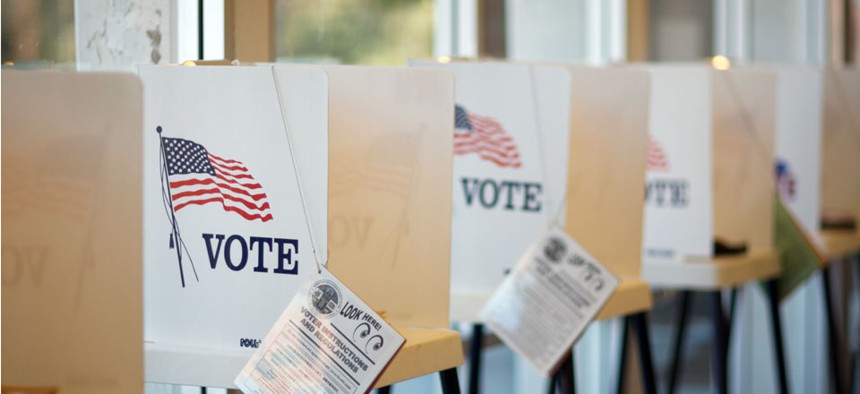
Thinkstock
Voters Don't Want to See Anyone Win
They 'want to punish Republicans but not reward Democrats,' says one pollster.
The day after Election Day 2012, the worst fear for many Republicans was that the GOP’s problems—in terms of the overall party brand and its image among minorities, young people, women, and moderates—would not improve. The biggest concern for many Democrats was that their success had peaked with President Obama’s reelection and that it would all be downhill after that, most likely as a result of second-term fatigue. (It’s worth noting that second-term fatigue has plagued almost every second-term administration in modern history; Democrats were correct in worrying that the dynamic would once again come into play.)
Well, a year later, where are we? The Gallup Organization reported last month that the Republican Party’s favorability rating had dropped to 28 percent, down 10 points from the previous month. This is the lowest recorded favorability rating for either party since Gallup started asking the question in 1992. Sixty-two percent of respondents in the October survey viewed the GOP unfavorably. The Republican Party’s favorable numbers have dropped 15 points since the Gallup survey in November 2012, from 43 percent to 28 percent, with unfavorable ratings up 12 points, from 50 percent to 62 percent.
Obama’s approval numbers have dropped 11 points, from 51 percent in Gallup’s polling at the time of last year’s election to 40 percent now. His unfavorable numbers are up 11 points, from 43 percent to 54 percent. More telling, only 38 percent of Americans agree with the statement that Obama “has a clear plan for solving the country’s problems,” just 42 percent say he “can manage government effectively,” and only 47 percent say he is a “strong and decisive leader,” down 6 points from June 2012. On “honest and trustworthy,” Obama has dropped from 60 percent in June 2012 to 50 percent now. Even on “understands the problems Americans face in their daily lives,” usually Obama’s strongest of the five characteristics that Gallup tests, he’s dropped 4 points since June 2012, from 58 percent to 54 percent. Obama is “underwater” on three of the issue concerns—not to mention, he has an approval rating of just 37 percent on health care policy and 39 percent on both the economy and foreign affairs. Clearly this is a president in a world of hurt. And with midterm elections often a referendum on the president, Obama’s predicament is a serious concern to Democrats on both ends of Pennsylvania Avenue and in every state capital.
Any Democrat looking at Obama’s numbers is likely to get depressed, just as any Republican looking at the GOP’s numbers will feel morose. For Democrats— even assuming that the HealthCare.gov website gets fixed in the next month or so—the reality of the Affordable Care Act’s problems, which extend beyond the technology challenges, are just now dawning on them. Plenty of other unpopular ACA shoes are set to drop. Public perception of the legislation has worsened, partly as a result of the bungled implementation. The program was too big, too complicated, and too ill-conceived, and it was pushed through too fast and is operating under a completely unrealistic timetable. These factors help explain why the Democratic Party’s favorability ratings have dropped since the last election as well, 8 points during that time, from 51 percent to 43 percent, with its unfavorable ratings up 6 points from 43 percent to 49 percent.
At the same time, Republicans don’t escape unscathed. The GOP can look forward to only more drama and trauma when the budget and debt-ceiling issues resurface early next year. While party leaders certainly hope the inevitable budget battle doesn’t inflict as much damage to the GOP numbers as the shutdown and debt-ceiling fights did in October, it is hard to see how anything they do will repair their problems with the public. In fact, it is unlikely that this Congress will accomplish much that will change voters’ perceptions. The Gallup Poll, for the first time in the 39 years it has asked the question, registered a congressional approval rating in the single digits, with only 9 percent approving of Congress’s performance. Disapproval stands at 86 percent, tied with two other instances when it was at that level. At a time when it is incredibly hard to identify anything that 86 percent of Americans agree on, disapproval of Congress manages to unite the public. To underscore the universal disenchantment: The congressional approval rating is 9 percent among Republicans, 8 percent among independents, and 10 percent among Democrats.
One Democratic pollster recently (and aptly) summed up the sentiment: “Voters want to punish Republicans but not reward Democrats.” This dynamic suggests we are in for either a highly muddled election outcome next year—hardly the stuff for a wave, because one party has to be rewarded and looked favorably upon to create a wave—or a highly volatile environment, what a meteorologist might describe as an “unstable air mass.” The latter dynamic could translate into a lot of surprise election outcomes, but not necessarily in any uniform direction.
This article appears in the November 16, 2013, edition of National Journal Magazine as Losers, All.






